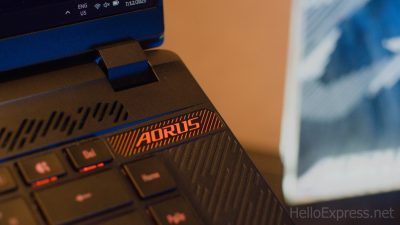
Qualcomm Unveils Snapdragon 8 Elite: A New Era of Mobile Power
TLDR:
- Qualcomm introduces Snapdragon 8 Elite, the world’s fastest mobile processor.
- Features include custom Qualcomm Oryon CPU, Adreno GPU, and Hexagon NPU.
- Enables on-device generative AI for enhanced experiences.
- Supports multi-modal AI for understanding speech, context, and images.
- Leading smartphone brands will launch devices with Snapdragon 8 Elite.
The Snapdragon 8 Elite marks yet another rebranding exercise for Qualcomm’s flagship smartphone chips, kicking off a new naming scheme. And for a good reason too, as the Snapdragon 8 Elite is no mere generational improvement like its predecessor, and instead makes a huge leap forward, deserving of the Elite name that was previously reserved for their premium laptop offerings.
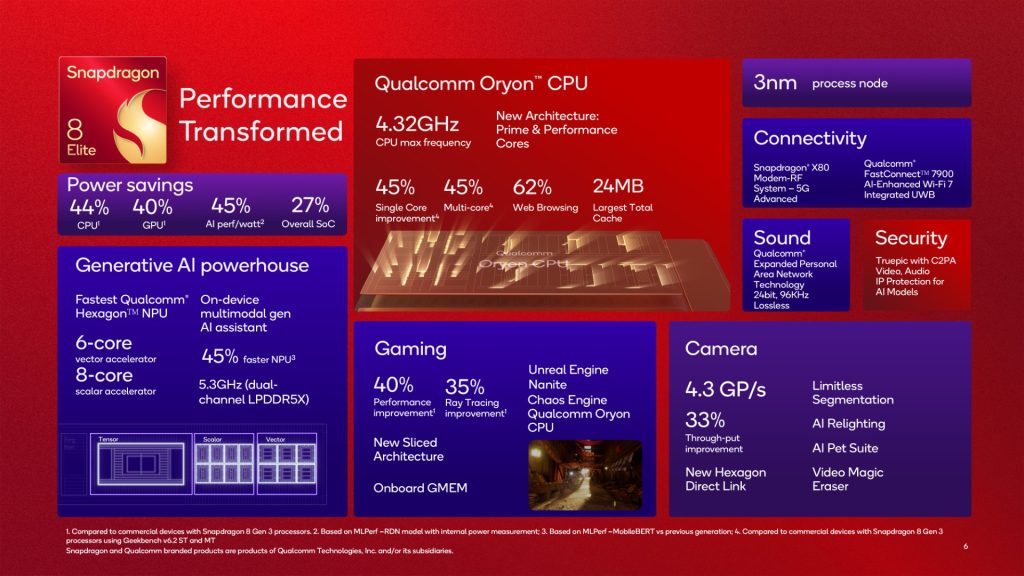
2nd Gen Oryon CPU cores — 50% faster, 44% more efficient

Unlike recent generations which harnessed cores based on off-the-shelf Arm CPU designs, Qualcomm has once again returned to their roots and designed a new all-custom architecture. The Snapdragon 8 Elite sports eight second-gen Oryon CPU cores, which have been optimized for mobile. Yes, you read it right, Qualcomm is ditching the big.LITTLE architecture in a big way (pun well intended) by equipping the Snapdragon 8 Elite with two Prime cores, clocked at 4.32GHz, and six Performance cores, clocked at a lower 3.53GHz.
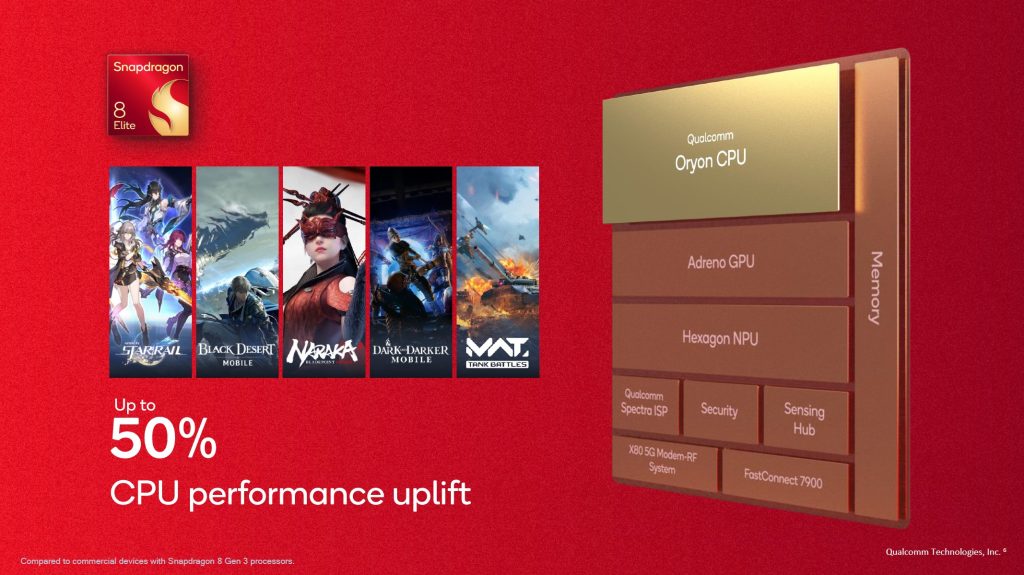
While comparing clock speeds across distinctly different microarchitectures mean little, the Prime core of the Snapdragon 8 Gen 3 for Galaxy runs at just 3.4GHz, a leisurely figure by comparison. Qualcomm claims that despite losing the efficiency cores, the Snapdragon 8 Elite delivers up to 44% better efficiency than its predecessor, thanks to the shift to the newer TSMC 3nm node. At the same time, they are promising 45% higher single-core and multi-core performance, a massive leap when compared to the glacial pace of performance uplifts we saw in the previous years.
New Adreno GPU — 40% faster, 40% more efficient
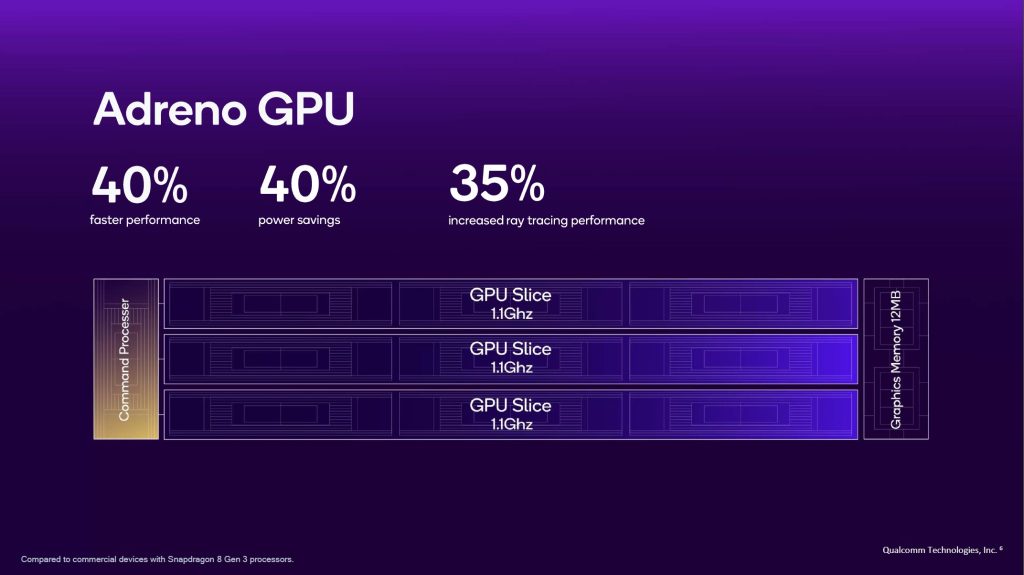
Mobile gamers may have yet to get their Crysis equivalent, but when it arrives, Qualcomm intends to be ready for it. The new Adreno GPU adopts a new sliced architecture for better power management and also resource allocation. Speaking of resource, we’re also getting 12MB of dedicated graphics memory, which can be huge as it means that the GPU here will be freed from having to play fetch in the system memory, which can be a substantial bottleneck.
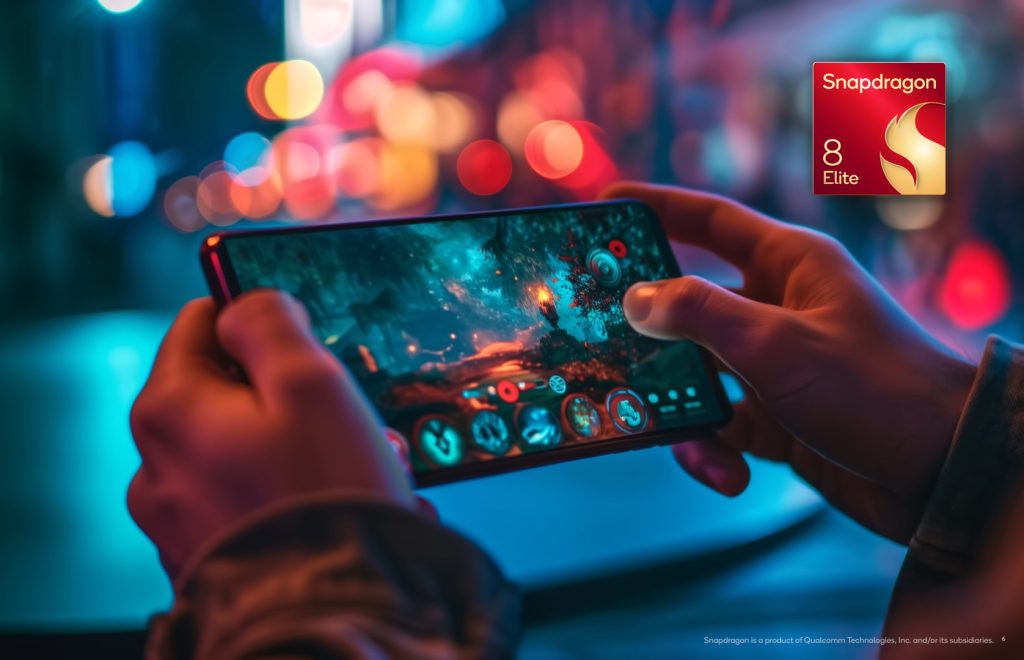
According to Qualcomm, the new GPU here in the Snapdragon 8 Gen 3 is 40% faster overall, with 35% faster ray tracing performance with 40% improved efficiency. The latter is supposed to translate to around 2.5 hours longer playtime, but that would also mean that your original playtime would have to be over 6 hours, a feat that’s unlikely to be possible unless you’re gaming on the ROG Phone 8 or something along those lines.
Faster multimodal AI

AI has been the major focus for Qualcomm, with the Snapdragon X Elite chips heralding a new era of Copilot+ PC before AMD and Intel came up with their answers. The new Hexagon NPU now has a total of 14 cores, with the Oryon CPU cores also chipping in for certain workloads. Qualcomm claims a more reasonable 45% improvement this year with the Snapdragon 8 Elite over last year’s Snapdragon 8 Gen 3, which itself claimed a humongous 98% improvement over its own predecessor.

And of course, with the current pace of computational photography, the physical camera sensors might just be taking a backseat, seeing all the AI-powered image processing that smartphones are capable of. The new Spectra ISP can handle triple 48MP cameras at the same time and 250-layer semantic segmentation, up from 12 layers with the Snapdragon 8 Gen 3. On top of this, the Snapdragon 8 Elite will support AI-driven real-time skin and sky adjustments, as well AI relighting and on-device video object eraser, to turn mediocre shots into incredible ones.
FastConnect 7900 with Bluetooth 6.0 and integrated UWB

Last year we saw Qualcomm reuse the FastConnect 7800 system from the Snapdragon 8 Gen 2 for the Snapdragon 8 Gen 3. But this year, we’re getting the new FastConnect 7900 that includes ultra-wide band (UWB). This essentially means all flagship Android phones will feature support for pinpoint precision when it comes to tracking, ala Apple AirTags. OEMs like Samsung previously had to add their own hardware to support this feature, but now with it being a part of the chip, we might see much wider adoption across the industry. Other new improvements include WiFi 7 with AI enhancements and Bluetooth 6.0 support.
Coming to you by end-October

As usual, there’s a wide variety of smartphone makers that have committed to adding Snapdragon 8 Elite-powered flagships to their lineup. The first might just be OnePlus, which will reportedly launch the OnePlus 13 as early as 31 October. Surprisingly, ASUS will also be joining in this early wave, with the ROG Phone 9 set for a 19 November launch. Stay tuned for more details!









